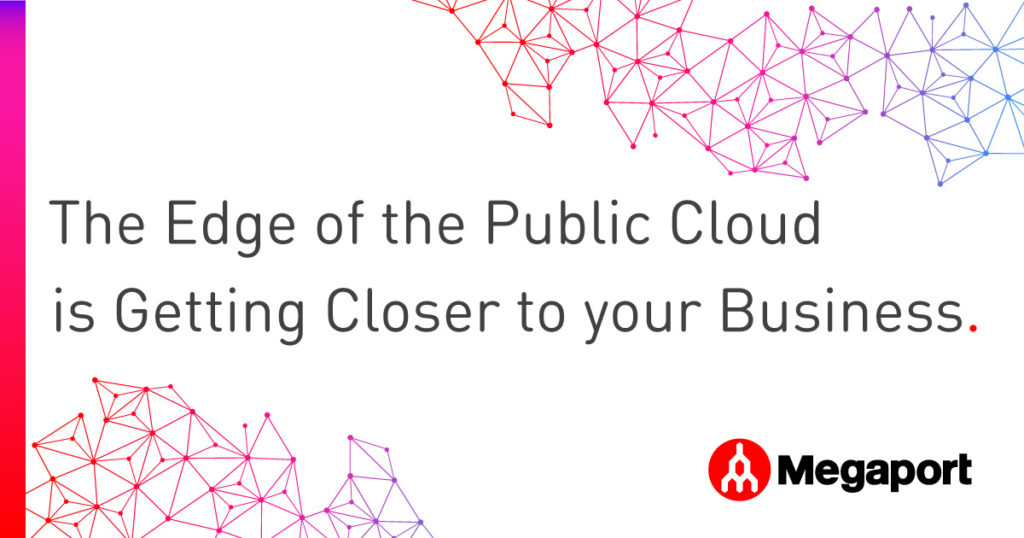
The Edge of the Public Cloud is Getting Closer to your Business
- May 22, 2019
- RSS Feed
How Network as a Service (NaaS) providers extend the reach of the public cloud to the enterprise.
When cloud technology first arrived on the enterprise scene, businesses and consumers alike were quickly won over by the idea that it was going to put IT resources and services ‘everywhere’.
By hosting services remotely and delivering them through an internet or private connection, it was set to completely remove the geographical and territorial boundaries that kept many companies from accessing the best solutions and resources. But as we know now, it didn’t quite work out that way – at least, not immediately.
The problem was, that initial vision of IT everywhere didn’t really account for enterprise connectivity demands. As organisations discovered that the reliability of cloud services depends on how you connect to them (and that dedicated private connectivity is all but mandatory for those that need enterprise-grade performance), they soon began to realise that the cloud isn’t really ‘everywhere’ at all.
Today, enterprise-grade cloud services are effectively available anywhere that’s within physical reach of a provider’s nearest on-ramp data centre. But fortunately for those that are out of reach, the rise of dedicated connectivity providers and the NaaS model is effectively extending the reach of Cloud Service Provider (CSP) networks, and bringing their edge closer to more customers than ever before.
Private connectivity providers physically extend the CSP edge
When a NaaS provider like Megaport physically connects one of its on-ramps into a CSP’s network, they effectively extend this network to a whole new physical location. Customers who previously couldn’t reach the CSP themselves, can now reach the partner’s on-ramp, and directly connect to the CSP’s services that way.
This approach is seeing CSPs’ reach extend across the globe, in many cases reaching entirely new territories and underserved regions. It’s a win/win for everyone involved; CSPs extend their reach, growth of the model sees Network as a Service grow in popularity, and customers can reach more services from more locations than ever.
Quite simply, it means more on-ramps, to more services and providers, in an ever-growing number of locations.
New tools and approaches are helping more happen at the edge than ever
The edge computing market is set to be worth $3.24bn USD by 2025. It’s one of the biggest and fastest-growing trends in enterprise, with many analysts and speculators expecting it to have a major impact on how high-bandwidth workloads are managed and processed across cloud environments in the years to come.
Supported by the microservices approach to development and service management, the edge computing model sees devices handle bandwidth-intensive tasks such as data aggregation and analytics themselves – integrating and communicating with the cloud, but not relying on it for processing.
Edge computing is set to become the new standard across enterprise IT – leading some to already call it “the new cloud”. While it’s certainly going to be transformational, that may be something of a misnomer. Edge computing represents the next evolution in cloud technology – not an entire IT revolution in and of itself.
So, what does it all mean for you?
For millions of businesses, the most immediate practical implication of these shifts is that they’ll be able to reliably and securely access a greater range of cloud services than ever before. Geographical factors will play a far smaller role in cloud partner choice, bringing true cloud freedom to organisations around the world.
Moving forward, the rise of IoT and the shift of computing power away from the core network should see greater capabilities be made available at the edge of cloud networks. As technology advances and larger workloads can be completed by cloud-connected endpoint devices, businesses with more remote operations will finally be able to unlock the full value of the cloud.
Completing resource-intensive computing work such as data analysis at the endpoint puts a lower burden of connectivity on organisations. Their communications with cloud networks become a lot lighter, helping to ensure their operations remain reliable regardless of how much bandwidth is available.
In short, the limits of what organisations can do and where they can do it are disappearing rapidly. The original cloud vision of “IT everywhere” is finally coming to fruition, and for organisations with remote operations that haven’t yet been able to access the cloud resources they really need, a new, hyper-connected era is beginning.
To find out more about how Megaport is bringing the edge of cloud networks closer to you, contact us today to discover how we can get you closer to the cloud resources you need.





